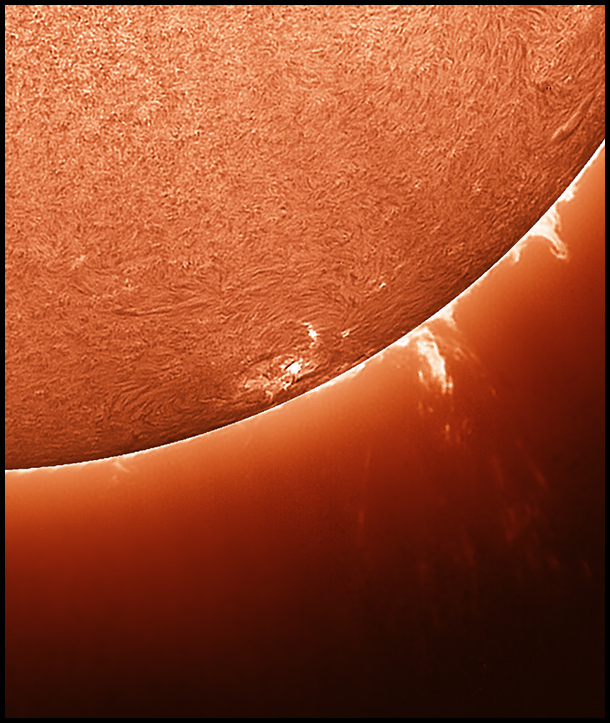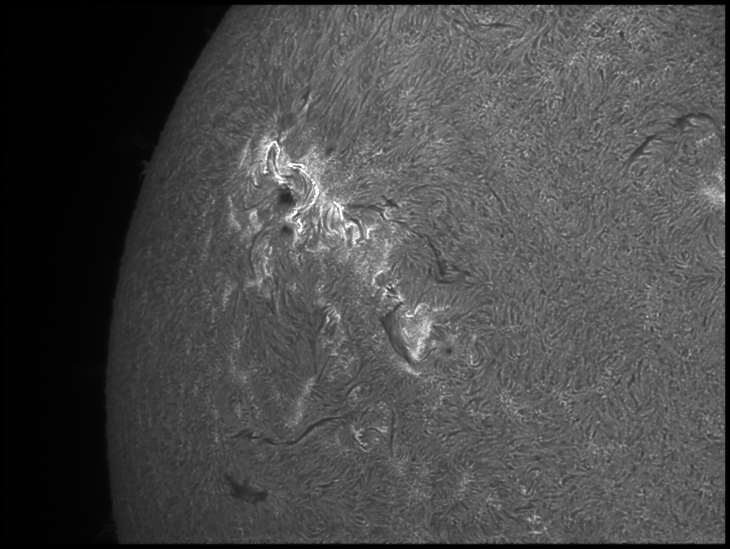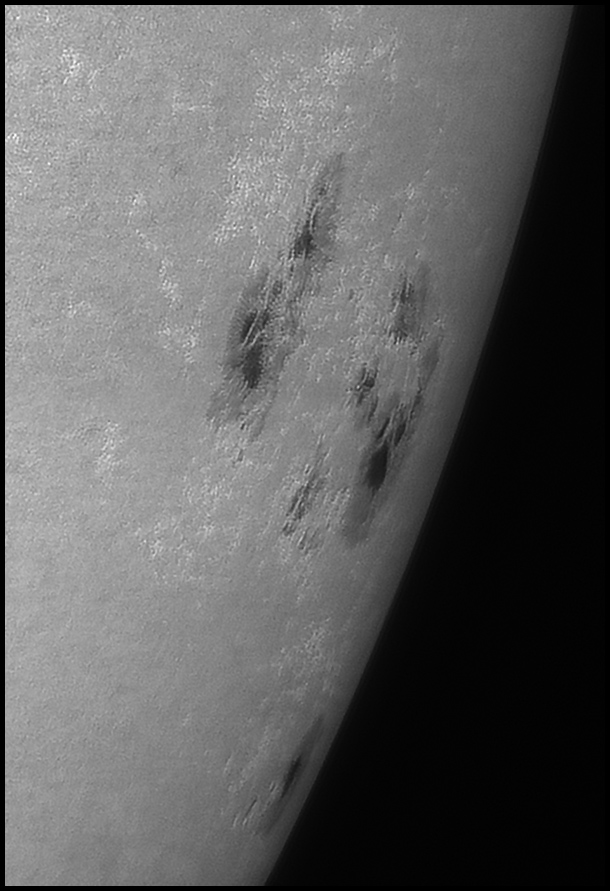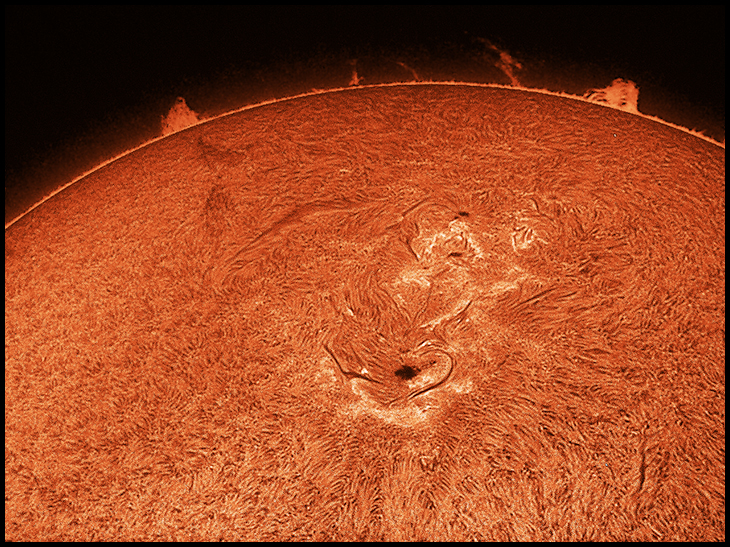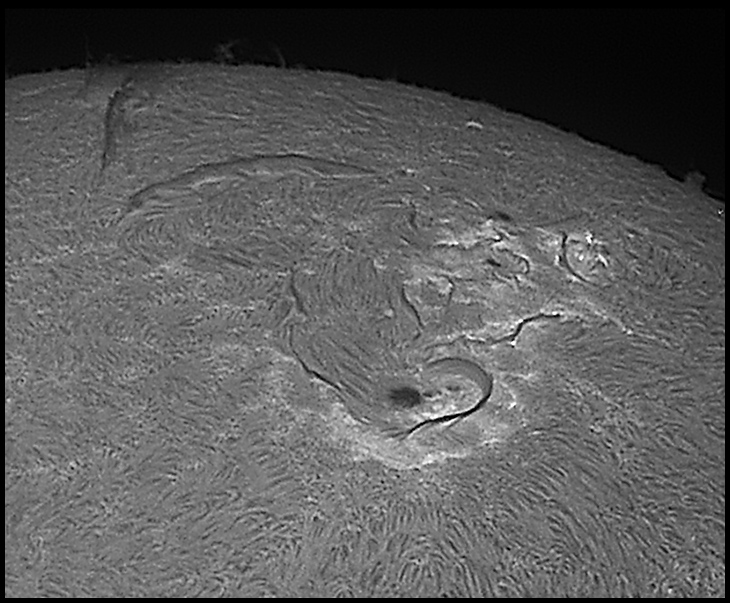|
AR 1515 leaves with a bang
I slewed to 1515's curtain call (which I glimpsed in the Lunt while lining up to take video) despite finding a brilliant flare in progress in AR 1520 when I got back inside to fine tune aim and focus. That flare reached above M6. The entire region was still smouldering when I got there a few minutes later:
AR1520 throws an M-tantrum
Beautiful flaring echoed all around this region for an hour or so after the big one, some hotspots flirted with M-class (according to GOES data) but most activity was in the C3 - C6 regime. I also took white light images of both AR1515 and AR1520. First, here's a two frame mosaic of the last we'll see of AR1515 unless it survives its farside transit:
Best 40% of two 400 frame captures
The photo above and the one below were both made with the AT10RC, barlow, Baader AstroSolar filter, and Baader 685NIR filter. The faculae around 1515 look over-processed to me, but maybe that's just what bright faculae are: discrete bright sources aligned like that. Who knew? More data, please, under steadier skies. Note that the image in the Maxbright diagonal is strongly attenuated compared to straight through the AT10RC. If you want to move from 4ms to sub-ms exposures, another 2-inch extension should do the trick (use more if you want to keep the 35mm Panoptic in the Maxbright nearly parfocal -- what *is* the path length through there?). Or I could revert to the Baader Continuum filter which doesn't flirt with the Maxbright's IR cutoff (but which has heretofore not produced such excellent contrast for me, either). More experiments, please. The star of the show was newcomer AR1520. It's worth clicking for the full-size image.
Best 10% of 1,500 frames
7/14/2012. A week of clouds hid the X-flare we've all been waiting for from AR1520. Here's the center of the active region a couple of days later. I would have missed the flare anyway; we were at KFC in JC, TN, waiting to see a man about a whistle.
AR1520. 1.2ms, 4db, gamma 0.5.
I removed the Maxbright diagonal (which trims the IR spectrum at about 700nm) from the imaging chain hoping to get much faster exposures. Definitely more light to work with, but today's highly variable skies (it rains one moment, is blisteringly clear the next) are not the ones to let me quanitify that. (It occurs to me that I'm making this measurement too hard. More in a bit.) The improvement is maybe only a stop or stop and a half rather than the two or three I expected. The most significant improvement this week is a better wavelet profile in Registax 5.1 which does not over-emphasize electronic noise while still enhancing real structures. I think I could use a little more EFL despite the generally poor seeing here in the NC foothills. An h-a capture at gamma 1.36 made a good raw data set from which to produce the following narrowband image of the same active region:
7/15/2012. Same targets, shooting between the raindrops one day on, through less stready air:
A modified Lunt. Way back when I first began using the Lunt 60THa, I also started thinking about using the tube sans objective as a hydrogen-alpha module in a larger refractor. I thought about mounting it in or behind an A-P 5-inch, a Kunming 6-inch (the same glass and tube, I am almost certain, is the brawn of the Lunt 152), a generic 4-inch achromat, and a 90mm F10.1 Orion. I messed with the 4-inch achromat and PVC tubing enough to know it could work. But there the project rested. Now, a couple of years on, others have pioneered this modification and generously provided the measurements needed to make it work well. Maybe it's time to take it up again with the hints available online. We went to a neighborhood party tonight, but about all I thought about was how to put that 90mm OTA to work as a solar telescope. I waved my hands and described how this should work several times. Each time, I said, I have an aluminum tube of the right diameter and wall thickness from which to machine the pieces, but I need one about 100mm longer... No, actually, I don't need any such thing. In fact, I may have every piece I need except a larger ERF, and I can test without that. The pieces I might not have are cheap and simple. More soon.
7/16/2012. I got out a yardstick and a micrometer and dry fitted everything on the dining room table. Yeah, this ought to work. I have the tough parts (4 rings for the tubes) but am missing the easy ones (suitable bolts to hold the rings to an aluminum strut for rigidity and to help hold spacing). But a simple connector made from a PVC tube will do by itself for testing. Line it with flocking paper; tape it all together to prove the design, adjust and shim as needed, then start looking for the metal bits to make it solid, transportable, easily taken down and put back, etc. Tomorrow we cut plastic and tape up the prototype. Thursday when I will be out anyway, I'll head for an iron mongery to find the missing bits.
:: top ::
|
© 2011, David Cortner
